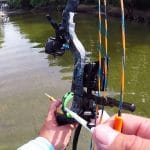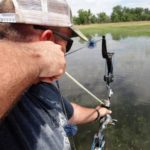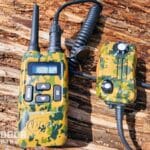Bowfishing is a fun and exciting sport that provides an excellent challenge to a traditional fishing trip. If you’re a hunter and enjoy a good round of bowhunting, then bowfishing will be right up your alley.
There are some differences between traditional fishing and bowfishing, though.
What is Bowfishing?
Whereas traditional fishing uses a fishing pole, reel, and fishing line, bowfishing removes the pole and adds in a bow and arrow setup. Bowfishing bows have a reel equipped with a special, braided line attached to a barbed arrow. A bow fisher uses the arrow to spearfish instead of a hook.
What is the Difference Between Fishing Line and Bowfishing Line?
Although you might think traditional fishing lines and bowfishing lines are interchangeable, that’s not entirely true.
Regular fishing line is typically smooth, monofilament, or fluorocarbon line. In contrast, bowfishing line is generally braided line, which resembles a thin rope. Braided line is stronger and allows for an increase in size and weight rating, which tolerates the added drag in bowfishing.
Bowfishing line travels with the arrow, which means the type of line you use needs to be designed in a way that will allow it to travel smoothly and without tangling.
If your line is coming from a spool, like on a traditional fishing reel, as opposed to a proper bowfishing reel, you’ll risk your line becoming tangled. This may make your arrow fall short of its target.
Bowfishing line also needs greater tensile strength in order to withstand a lot of drag. When you pierce a fish with your arrow, you’re going to be reeling in the weight of the fish and the arrow.
Bowfishing arrows are heavier than most spincasting bait. And You generally target larger fish when bowfishing, like carp and catfish. These fish can be huge, so you’re going to need tough line.
Complete your bowfishing gear setup:
Best Arrow Rests for Bowfishing & What To Look For
What to Look for in Bowfishing Line
When choosing your bowfishing line, there are a few things to look for.
Material
There are three common materials for bowfishing line: nylon, Spectra, and Dacron.
Nylon
Nylon is an excellent shock absorber and knots really well, making it ideal for larger quarries.
However, nylon has its downsides. It retains its shape, which can tangle when it comes unspooled. It’s also larger than other materials, which means you get less line in the same amount of space you would if you chose Spectra or Dacron.
Spectra
Spectra is the most durable of all of the line materials. It also doesn’t have the same issue with shape retention that nylon has, which helps prevent tangling.
The main downside to Spectra is that it’s sensitive to the heat caused when the line is let out. The heat causes it to shrink, limiting the line’s lifespan.
Dacron
Dacron is made of a similar material to Spectra and shares its strength. However, Dacron differs from Spectra because it’s more flexible, making it a better shock absorber.
Dacron is a good middle ground between nylon and Spectra. That said, it’s also heavier than both, which will add some weight to your bow that you’ll need to compensate for.
Test Strength
Choose a line that’s strong enough to reel in the fish you’re aiming to catch. For example, if you’re going to be out fishing for big fat carp, choose line like AMS Bowfishing line (affiliate link, FYI) with a test strength of 400 pounds.
Abrasion Resistance
If you’re going bowfishing, you may encounter a lot of hazards that can damage your line. Nylon is typically more abrasion-resistant, so if you plan to fish in rocky waters, that will likely be your best bet.
When choosing your bowfishing line, be sure to choose one that suits your needs. Although it may be tempting to use that roll of regular fishing line that’s been sitting in your tackle box, you should resist that temptation and buy some bowfishing line. Otherwise you may end up leaving your arrow, and maybe ven a big fish, in the water when your line breaks.
The right tools will get you the best results, no matter what.












